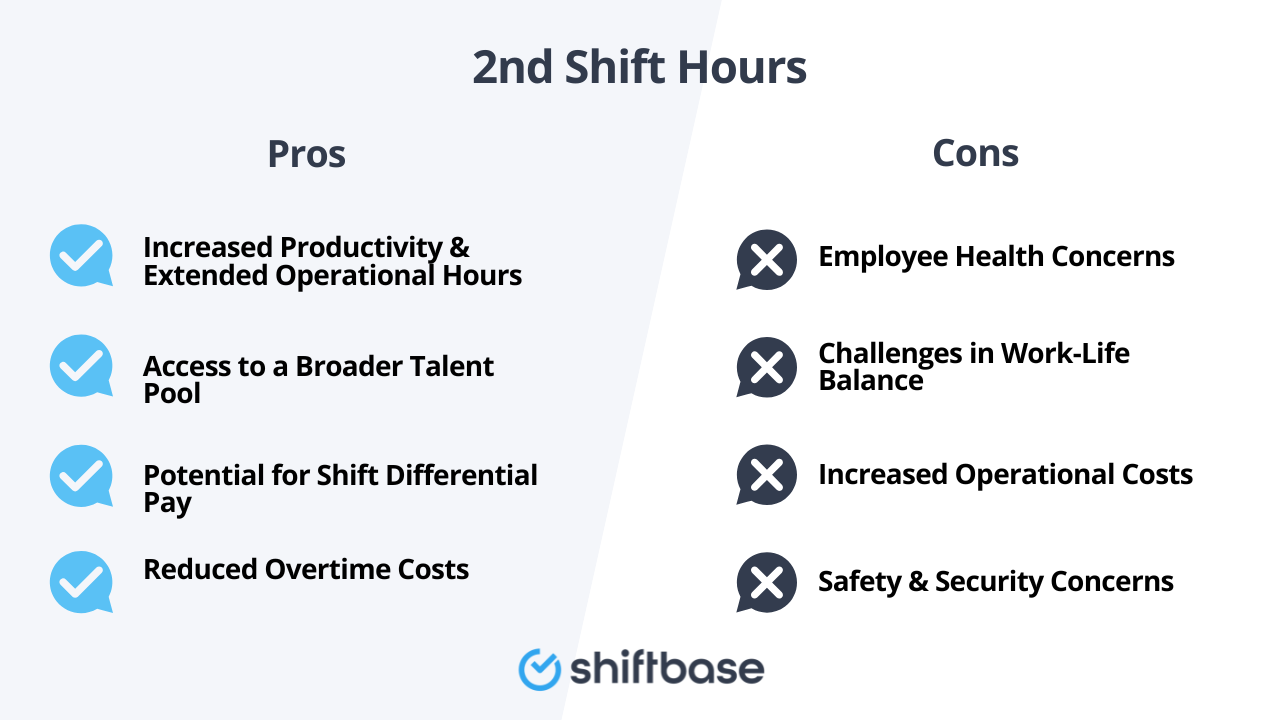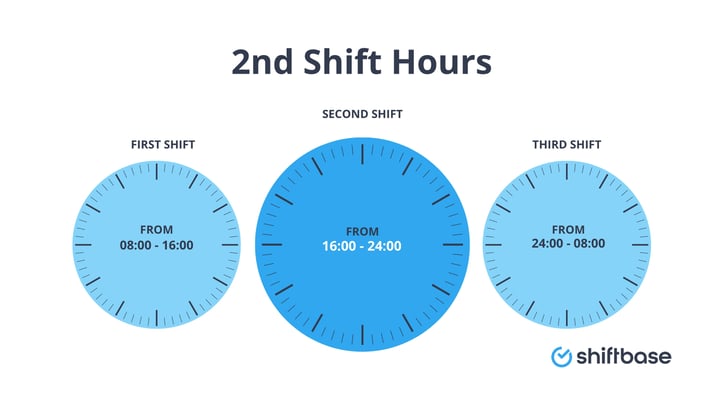What is a 2nd shift?
A second shift, also known as the afternoon shift or swing shift, refers to a work schedule that typically begins in the mid to late afternoon and concludes late at night. This shift bridges the gap between the traditional daytime (first shift) and nighttime (third shift) work periods.
What hours are second shift?
Typical second shift hours are:
- Start Time: Generally between 3:00 PM and 5:00 PM.
- End Time: Typically between 11:00 PM and 1:00 AM.
These hours can vary based on industry standards and specific company policies. For instance, a manufacturing plant might operate a second shift from 4:00 PM to midnight, while a hospital could have slightly different hours to accommodate patient care needs.
Pros and cons of second shift hours
Employers considering implementing second shift hours should weigh several advantages and disadvantages to determine their suitability for their operations and workforce.
Pros
- Increased Productivity and Extended Operational Hours: Implementing a second shift allows businesses to maximize equipment utilization and maintain continuous operations, leading to higher productivity levels.
- Access to a Broader Talent Pool: Offering second shift positions can attract individuals seeking non-traditional work hours, such as students or those with daytime commitments, thereby expanding the potential workforce.
- Potential for Shift Differential Pay: Employers may offer higher wages for second shift positions to compensate for non-standard hours, making these roles more attractive to potential employees.
- Reduced Overtime Costs: By distributing workloads across multiple shifts, employers can minimize the need for overtime payments, leading to cost savings.
Cons
-
Employee Health Concerns: Working non-traditional hours can disrupt circadian rhythms, potentially leading to health issues such as sleep disorders, fatigue, and decreased mental well-being.
-
Challenges in Work-Life Balance: Second shift schedules may interfere with employees' social lives and family time, potentially leading to decreased job satisfaction and higher turnover rates.
-
Increased Operational Costs: Maintaining facilities and providing support services during extended hours can result in higher utility expenses and administrative overheads.
-
Safety and Security Concerns: Employees commuting during late-night hours may face increased safety risks, necessitating additional measures to ensure their well-being.
Employers should carefully assess these factors in relation to their specific industry requirements and employee needs to make informed decisions about implementing second shift schedules.

How to create a 2nd shift work schedule
Creating a second shift work schedule requires careful consideration to ensure it meets your business needs while also supporting your employees' well-being. Here's a guide to help you establish an effective second-shift schedule for your team:
Step 1. Identify the need for second-shift hours
Determine if your business requires a second shift to accommodate customers, meet production demands, or manage continuous operations. This is common in industries where operations extend beyond regular daytime hours.
Step 2. Define the hours for the second shift
A typical second shift runs during the afternoon and night, often starting in the late afternoon and ending at midnight. Establish clear second-shift hours, considering the nature of the job and the industry norms.
Step 3. Consider different shifts and rotating schedules
To promote a healthy work-life balance, consider implementing different shifts, such as split shifts or rotating shifts. This can help employees maintain a regular sleep schedule and avoid burnout.
Step 4. Factor in commuting and off-peak hours
Schedule the second shift to help employees avoid rush hour traffic. This can save time and reduce stress, improving overall energy levels and job satisfaction.
Step 5. Ensure fair and equitable work shifts
Balance the workload by rotating employees through different shifts, including the second shift, morning shift, and night shift. This helps in maintaining fairness and keeps energy levels balanced.
Step 6. Incorporate flexibility for personal commitments
Recognize that employees may have other commitments outside of work. Offer flexible scheduling options, such as four-hour shifts or the option to choose the right shift that suits their personal life.
Step 7. Implement safety measures for night hours
Ensure safety for employees working at night by implementing robust safety measures and providing health care support.
Step 8. Align with legal requirements and company policies
Make second shift hours mandatory as per business needs but ensure compliance with labor laws and your company's policies.
Industries that use second-shift
Several industries utilize second-shift schedules to meet their operational demands, accommodate customer needs, and ensure continuous operations. Here are some of the key industries where second-shift work is prevalent:
-
Manufacturing and Production: One of the most common industries for second-shift work, manufacturing plants often run multiple shifts to maintain productivity and meet production targets.
-
Health Care: Hospitals and healthcare facilities operate 24/7, requiring staff for various shifts, including the second shift, to provide continuous patient care.
-
Retail: Some retail stores, especially large supermarkets, and 24-hour establishments, employ second-shift workers to cater to customers during evening hours and prepare for the next day.
-
Information Technology (IT) and Data Centers: To ensure continuous operations and manage networks effectively, IT companies and data centers often have employees working in shifts, including the second shift.
-
Security Services: Security needs are round-the-clock, making second shifts essential in this sector for protecting properties and individuals.
-
Hospitality and Food Services: Restaurants, hotels, and other hospitality businesses often require a second shift to serve customers during dinner hours and manage late-night operations.
-
Emergency Services: Firefighters, police officers, and emergency medical technicians (EMTs) often work in shifts, including second shifts, to provide essential services at all hours.
-
Customer Service and Call Centers: To accommodate different time zones and provide round-the-clock customer support, many call centers operate with second-shift schedules.
-
Transportation and Delivery Services: Public transportation, as well as delivery services, often include second shifts to manage peak times and late-night operations.
-
Media and Broadcasting: To keep up with the demand for news and entertainment, media houses and broadcasting companies often have employees working different shifts.
These industries, among others, find the second shift crucial for their operations, offering services beyond the traditional 9-to-5 workday.
Employers in these sectors must consider the unique challenges and benefits of second-shift work to effectively manage their workforce and maintain a healthy work-life balance for their employees.
Tools and software to manage 2nd shift work schedule

Effectively managing a second-shift work schedule requires the right tools and software. These solutions can help streamline scheduling, improve communication, and ensure compliance with labor laws. Here’s a look at some of the tools and software that can assist in managing your second-shift workforce:
Time and attendance systems
These systems help track the hours that each employee works, which is particularly important for managing different shifts and overtime. Look for software that allows employees to clock in and out easily and provides real-time attendance data.
Useful read: What to Look For in a Clock In Clock Out System
Scheduling software
Specialized scheduling software can help you create and manage shift schedules, including second shifts. These tools often offer features like drag-and-drop scheduling, automatic schedule conflict resolution, and mobile access for employees.
Communication platforms
Effective communication is key, especially when employees work at different times. Utilize platforms that enable instant messaging, shift reminders, and schedule updates. This ensures everyone stays informed and can easily communicate shift changes or requests.
HR management systems
Comprehensive HR systems can integrate scheduling, time tracking, payroll, and other HR functions. These systems provide a holistic approach to managing second-shift workers and ensuring compliance with labor laws.
Mobile Apps
Many scheduling and time-tracking tools offer mobile apps, allowing employees to view their schedules, swap shifts, andrequest time off from their phones. This adds flexibility and convenience for second-shift workers.
Cloud-based solutions
Cloud-based scheduling tools offer the advantage of being accessible from anywhere, which is ideal for managers who need to manage schedules remotely or across multiple locations.
Task management software
For more detailed oversight, task management tools can be used to assign specific tasks to employees on different shifts, ensuring that all necessary work is completed efficiently.
Analytics and reporting tools
Advanced scheduling software often includes analytics features, allowing you to analyze staffing levels, labor costs, and productivity. This data can be invaluable for optimizing your second shift schedules.
Employee self-service portals
These portals allow employees to manage their schedules to some extent, including shift trades and leave requests, which can greatly reduce the administrative burden on managers.
By leveraging these tools and software solutions, you can more effectively manage your second-shift workforce, ensure fair and efficient scheduling, and maintain high levels of productivity and employee satisfaction.

Employee scheduling and Time-tracking software!
Conclusion
Managing a second-shift work schedule effectively is crucial for businesses operating beyond regular hours. Understanding its dynamics, employing the right tools, and prioritizing employee well-being can transform second-shift schedules into a valuable asset for any company, balancing operational needs with a healthy work environment.
Mastering 2nd shift scheduling with Shiftbase
Managing the unique demands of 2nd shift hours can be a challenging task, but Shiftbase offers an ideal solution. With its robust employee scheduling feature, Shiftbase simplifies the process of organizing and adjusting afternoon to evening shifts.
This is crucial for businesses that operate beyond the standard 9-to-5 schedule. Furthermore, Shiftbase's time tracking capabilities ensure accurate recording of hours worked during these unconventional times, aiding in payroll accuracy and compliance. Additionally, its absence management system helps maintain consistent staffing levels, a critical aspect for operations running into the night.
To streamline your management of 2nd shift hours and see the difference Shiftbase can make, take advantage of a free 14-day trial by signing up here. Discover how Shiftbase can transform your workforce management and adapt to your unique scheduling needs.



